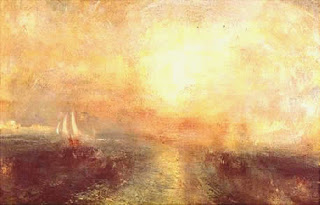Easter sermon

Easter Sunday and K- and I went to the Easter service at St Paul's Cathedral this morning - a hugely well attended event as it turned out, and I was surprised although I shouldn't have been. I'm so rarely at a Sunday service these days. It generates a spark of nostalgia and something else - I thought of Dr Johnson lamenting his lack of devotion at his annual Easter Communion, resolving to amend his life and then doing exactly the same thing next year. Richard Charteris, Bishop of London, gave the sermon which started off with the usual slightly clumsy attempt to be newsy and relevant, and then moved onto the main theme of the address which was that of fracture and fissure: the event of the resurrection, according to Charteris, 'opened a fissure in the earth’s crust through which God’s future could stream into the world.'
I received this as a very visual image. The future (God's future, indeed) as a stream of light, pouring in through a rent in the fabric of the universe. If there is no fissure, no tearing of the tight weave of the world, then the light might offer a mute glow, a slight warmth, but certainly no streaming.
The association of grace coming from brokenness isn't that original, I know. It's that idea of a crisis providing opportunity rather than just desperation (I understand that in Chinese the word crisis also means 'opportunity'). But interesting to have it related to the resurrection rather than, say, the broken body of the crucified Christ or symbolically the breaking bread. As though the resurrection isn't a resolution or a closure of that particular passion narrative but a continuation of it on a vast, eternal scale. A brokenness = light streaming in.
Two cultural references in my mind. The first, paintings by Turner, the late ones, the experiments with light. In January I met a friend who is a contemplative monk. He is rarely in London and suggested we met at the Tate. We wandered around having intelligent conversation about various artworks but when we got to the Clore gallery we were silent and Fr G- sat for a long time in contemplation. Later I learned that Turner's last words were reputed to have been 'The Sun is God'.
The sun is such a powerful symbol. Literally generated by fissure and energy of course, though not, in Turner's work, streaming in through a fracture or fissure in the natural world. Secondly then, there's a sonnet by Seamus Heaney, 'the Skylight', that equates the disordered introduction of a skylight into a previously neatly sealed attic room with an influx of light and grace. Here's the sestet:
But when the slates came off, extravagant
Sky entered and held surprise wide open.
For days I felt like an inhabitant
Of that house where the man sick of the palsy
Was lowered through the roof, had his sins forgiven,
Was healed, took up his bed and walked away.
This poem, more than the light drenched Turner painting(s), explores the risk and surprising consequences of creating that opening in an otherwise closed location.
On reflection though, a real 'fissure' implies still more disturbance and breakage prior to, and instrinsic to, the influx of streaming light/grace. More like life with all its tendency to break down/open than a finely wrought piece of art or design or craft even. I went up to join a carefully choreographed communion queue. The Bishop's amethyst glowed purple in its gold setting. Then the service ended and the great doors of St Paul's were pushed wide open to let us all pour out into a largely oblivious Sunday London.

Comments
Post a Comment